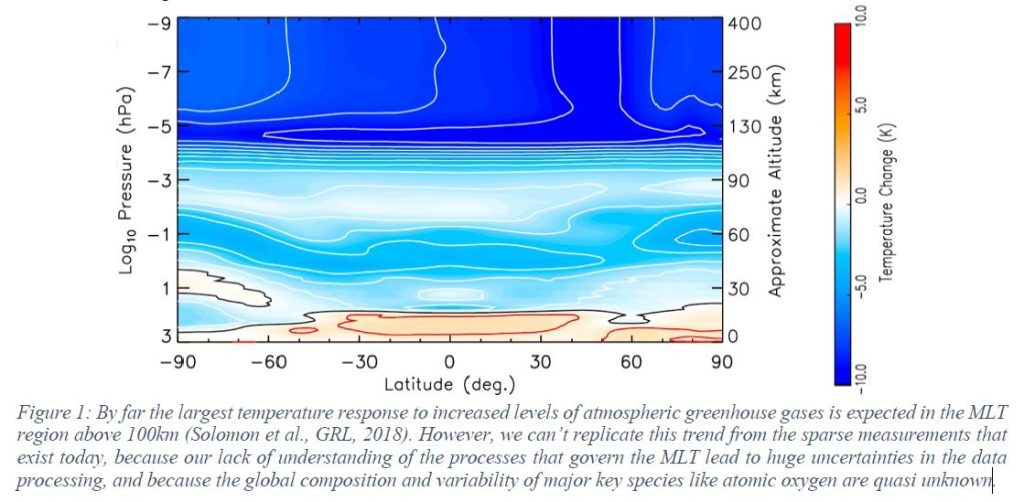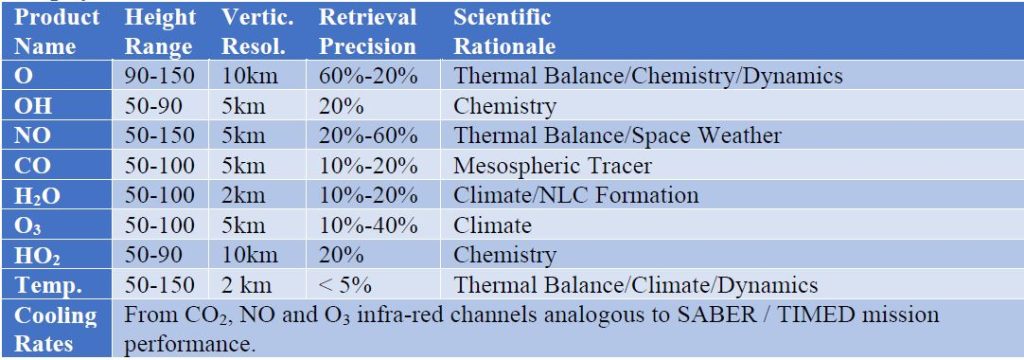by Dr Daniel Gerber
Scientific Motivation
The mesosphere – lower thermosphere (MLT) is the transition region between Earth’s atmosphere and space and is influenced strongly both from the atmosphere below and from incoming solar UV, X-rays and charged particles. These drive chemical, radiative and dynamical processes which couple the MLT with the lower atmosphere and with space weather. The detailed processes that govern the MLT are poorly understood, however, because this is the least well-observed region of the atmosphere. For instance, we do not even know if the mesosphere is in global mean radiative balance on monthly or seasonal timescales. What we know about the MLT today is derived from measurement of radiative fluxes in the infrared (IR), which tell us about the thermal balance of the MLT, but give an incomplete picture of its chemical composition, both in terms of the measured geophysical products, as well as their altitude coverage.

Observed negative temperature trends indicate that the MLT is a predictive indicator of climate change, but current research also indicates that a significant part of this signal could be linked to stratospheric ozone recovery. Measuring the composition of the MLT is scientifically significant in its own right, but it will also help to disentangle our interpretation of heat fluxes in the MLT and lower layers of the atmosphere, and therefore to better understand processes of climate forcing. Direct measurements at multiple THz frequencies are missing, because – until today – their technological requirements were prohibitive for space (only large and expensive gas lasers could provide enough power to pump a heterodyne detector). By exploiting newly developed technology, the LOCUS THz limb-sounder overcomes this limitation and will provide for the first-time direct measurements of the global height-resolved atomic oxygen (O) distributions over several years, enabling examination of inter-annual variability, as well as seasonal and short-term variations.
Mission Objectives & Benefits
LOCUS will address the following four mission objectives, which all revolve around a better understanding of climate- and space weather-related processes:
- Energy Balance: Direct abundance measurement of the key species atomic oxygen will allow us to understand the physical processes behind the observed upper-atmospheric cooling rates, and help us understand if and how they are linked to climate change. Crucially, when combined with infrared heat flux measurements, abundance measurements of atomic oxygen will finally reveal the true O-CO2 quenching rates, thus resolving an old conundrum and adding significant new value to decades of existing infrared measurements.
ESA Earth Explorer 4 10th Call – LOCUS – CEE10/006 - Improved Atmospheric Models: Atmospheric models have become crucial to our society, with the economy and transport heavily depending on reliable weather forecast, and government policies depending on the predictions of climate change from global climate models. The performance of climate and weather prediction models is significantly improved by including the MLT region, but measurements of the MLT composition – which LOCUS will provide – are needed to validate them.
- Energetic Particle Precipitation: Abundance measurements of NO during space weather events will help understand the impact that space weather has on the physics and chemistry of the upper- and middle atmosphere, and thus on our climate.
- Noctilucent Clouds: Measurements of humidity and temperature will help understand the processes behind the formation of these high-altitude clouds, whose increased occurrence is almost certainly linked to climate change.
Geophysical Parameters

Mission Implementation Concept
LOCUS is a limb-sounding mission comprising a novel terahertz (THz) frequency heterodyne spectrometer, exploiting quantum cascade laser (QCL) local oscillators (LOs) in space for the first time, along with an IR filter radiometer built on the SABER concept, though potentially exploiting new compact imaging IR array technology. LOCUS will be deployed in a polar, sun synchronous, low Earth orbit, scanning the atmospheric limb between 50 km and 150 km at ≤ 2 km vertical sampling and a longitudinal spacing of ≤ 1000 km (9°). Atmospheric emission spectra are simultaneously recorded in five THz bands and seven IR channels. The measured THz spectra (and IR radiances) will be downloaded to ground stations each orbit, and converted to temperature and mixing ratio profiles by an optimal estimation retrieval scheme. The nominal mode of operation is daily global sampling. Alternative modes are foreseen for e.g. NLC campaigns (finer vertical sampling over a reduced altitude range). A mission-duration of three years will enable inter-annual variability to be observed as well as seasonal and shorter-term variability. The mission is compatible with a small satellite platform (i.e. Astrobus-S, SSTL-150) and therefore with a large selection of launchers. The use of semiconductor LOs, passive detection, and closed-cycle mini coolers make LOCUS a low-cost mission by design.
Impact
LOCUS will permit the study of MLT links with climate and space weather. Its unique and comprehensive measurement suite will provide the global observations required to investigate processes controlling the composition and energetics of the MLT and links to the lower atmosphere (THz instrument for composition, IR instrument for cooling rates). In doing so, it fills a crucial knowledge gap in this least well known region of the atmosphere. Societal benefits are substantially improved weather and climate prediction models. LOCUS will resolve an age-old conundrum of what the true quenching rates of greenhouse gases with upper-atmospheric atomic oxygen are, resulting in much more accurate determination of temperature trends from infrared measurements present, past, and future.
